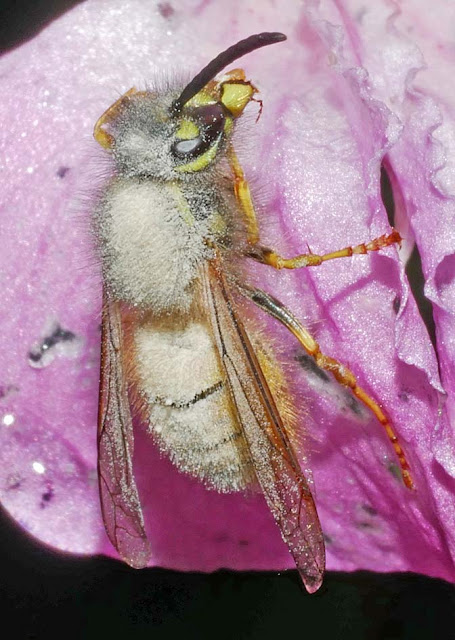Himalayan balsam is notoriously invasive and the chances of ever eliminating it on a large scale seem negligible. Even when plants are pulled up there is always a large seed bank in the soil, and flooding carries the seeds far and wide along river valleys. But it does have at least one virtue: it's a very rich source of nectar late in the year, when few native nectar-rich plants are available. Bees and wasps find it irresistible.
The flowers have a distinctive pollination mechanism, with anthers positioned in the roof of the flower, so they deposit pollen very efficiently on the upper thorax of visiting insects, like the honeybee above and the wasp below.
Showing posts with label Himalayan balsam. Show all posts
Showing posts with label Himalayan balsam. Show all posts
Monday, October 2, 2023
Himalayan balsam nectar
Wednesday, October 7, 2009
Honeybee in Disguise
The first time I saw one of these bees with a distinctive band of white hairs along its thorax I spent some time leafing through field guides unsuccessfully trying to name it – until I realised that it was a honeybee that had been feeding on Himalayan balsam flowers (see http://cabinetofcuriosities-greenfingers.blogspot.com/search/label/Himalayan%20balsam). When the bee pushes its way into this flower to reach the nectar the hairs on its thorax pick up white pollen from the stamens that are in the roof of the floral chamber. As it backs out it brushes the stamens away exposing the stigma, ready for the next pollen-laden visitor to the balsam flower to deliver its stripe of pollen to the sticky stigma. I've also seen wasps with tell-tale white thoraxes which have evidently been collecting nectar from the same source. I photographed this ‘striped’ honeybee today on wild carrot, after it had exited the Himalayan balsam flowers nearby.
Labels:
Himalayan balsam,
honeybee
Wednesday, July 15, 2009
Botanical Xenophobia?




There’s a long-standing belief that dense riverbank stands of Himalayan balsam Impatiens glandulifera – like these plants flowering beside the river Tyne at Corbridge - represent a major threat to our native riverbank plants. The press loves a good ‘alien invader’ story that predicts the extermination of our native wildlife by some botanical ‘foreigner’, and it’s true that some introduced plant species that have escaped into the wild, like Japanese knotweed and Australian swamp stonecrop for example, have damaged natural habitats, but in the case of Himalayan balsam the threat is more imagined than real. Although it’s a tall, fast-growing and very conspicuous plant it’s an annual, and doesn’t compete very effectively with established riverbank perennial native plants that have dense root systems. Two recent research projects have demonstrated that it isn’t a dire threat to our flora and one very recent one has shown that it’s a positive asset as far as bees are concerned. It’s a rich source of nectar and pollen and bees visit it constantly. Sadly, once these 'alien invader' stories take root they tend persist, no matter how good the scientific evidence is that shows they are a myth. So I dare say well-meaning but misguided ‘conservationists’ will organise many more ‘balsam bashing’ events to tackle this imagined threat. Still, the plant is well established almost everywhere now, and its exploding seed pods disperse its seeds very effectively, so it will probably continue to provide a valuable food source for our hard-pressed bees for a long time to come.
Subscribe to:
Posts (Atom)





























